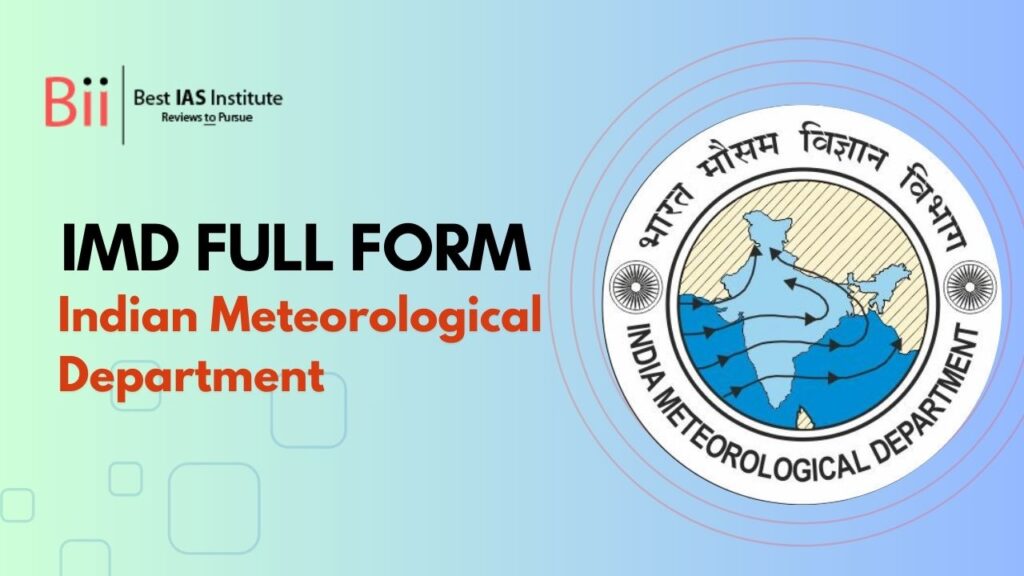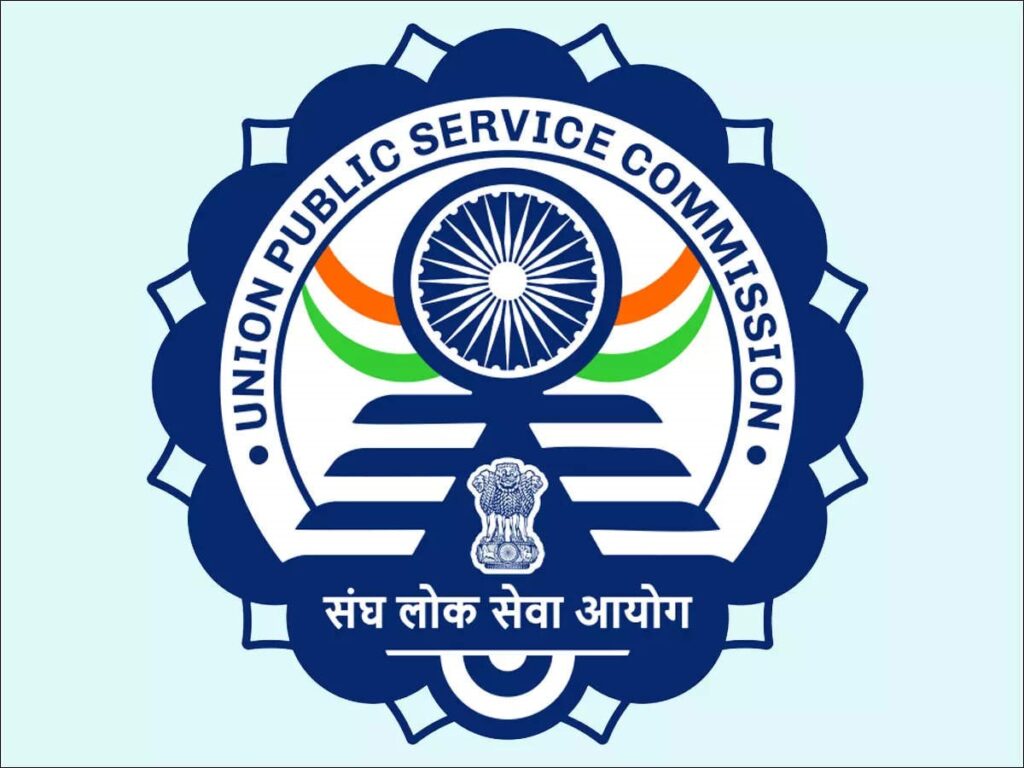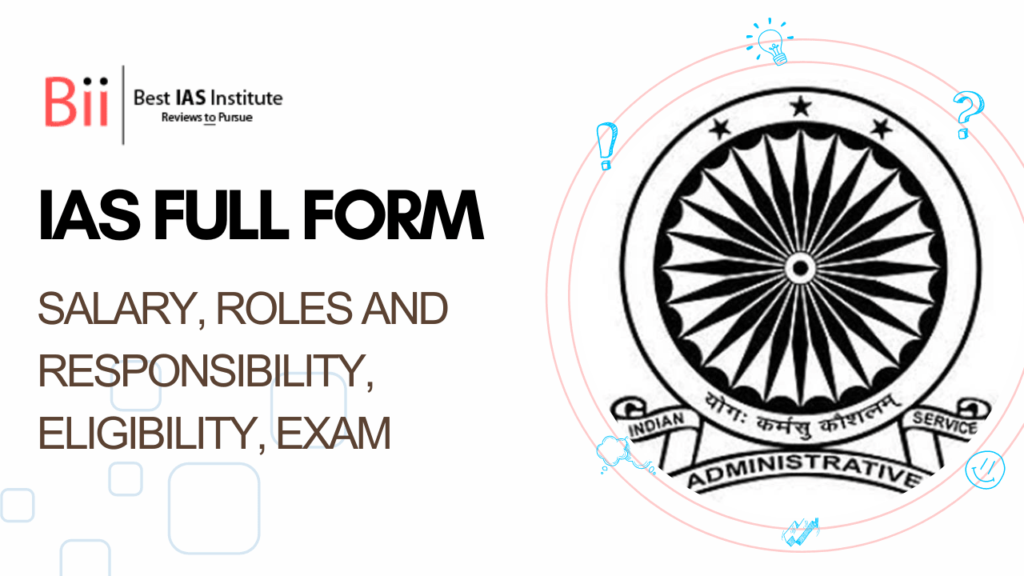
What is the full form of IMD ?
IMD stands for India Meteorological Department. It is an agency of the Ministry of Earth Sciences (MoES), Government of India. IMD mainly deals with weather related issues and weather forecasting, seismology etc. IMD is headquartered in New Delhi and has regional offices all over India.
| IMD Full Form – India Meteorological Department | |
| IMD Full Form (English) | Indian Meteorological Department |
| IMD Full Form (Hindi) | भारतीय मौसम विज्ञान विभाग |
| IMD Established Year | 1875 |
| Current Director of IMD | Dr. Mrutyunjay Mohapatra . |
Origin of Indian Meteorological Department (IMD)
The Indian Meteorological Department was established during British rule when India was gaining independence. In 1864 there was a tropical storm in Calcutta. The subsequent failure of the rains in 1866 and 1871 affected famine in various parts of India. These events paved the way for the creation of a centralized organization to collect and analyze climate data. It was for this purpose that the IMD was established on January 15, 1875 and Henry Francis Blanford was the first weather journalist.
Initially, IMD was headquartered in Shimla and had regional offices in Mumbai, Kolkata, Chennai, Nagpur and Delhi. On April 27, 1949, IMD became a member of the World Meteorological Organization. IMD as an agency is really important in India due to the unreliable monsoon season and impact of rainfall on agriculture.
Meaning of Indian Meteorological Department (IMD)
The Indian Meteorological Department (IMD) is the government agency that monitors and forecasts the weather across India. It collects data from a variety of sources such as satellites, radars and stations on the ground and analyzes the weather to make weather forecasts.
IMD provides weather advisories, warnings and forecasts to help citizens, government agencies and agencies prepare and respond to weather-related storms, rains and heat Its objectives are to provide public safety, agricultural systems, disasters management and the overall community resilience to climate impacts.
Organization Structure of Indian Meteorological Department (IMD)
The Indian Meteorological Department (IMD) has a hierarchical organizational structure. At the top is the Director-General of the National Weather Service. Next are Deputy Directors of Regional Meteorological Centers across India. Department heads lead specific departments such as forecasting, analytics and training.
Below them are scientists and meteorologists responsible for data analysis, weather forecasting and analysis. Technicians support operations by maintaining equipment and gathering information. Administrators deal with day-to-day tasks such as finance, human resources and logistics. This structured system ensures proper planning and weather management across the country.
Objectives of Indian Meteorological Department (IMD)
The objectives of the Indian Meteorological Department (IMD) are multifaceted and important to ensure public safety, support infrastructure and contribute to scientific progress:
- Accurate weather forecasting: Provide timely and accurate weather forecasts for daily planning, disaster preparedness, and long-term weather forecasting.
- Early Warning Systems: Provide warnings and advisories for severe weather events such as tornadoes, heavy rains, heat waves and thunderstorms to reduce risks and ensure public safety.
- Climate Research: Analyze climate patterns, changes, and changes to understand and mitigate climate impacts on society and ecosystems.
- Agricultural Support: Provide climate information and advice to farmers on crop management, irrigation systems and pest management.
- International collaboration: Collaborate with global climate agencies to share information, research findings and best practices to improve climate performance around the world.
- Technological Advancement: Embrace advanced technologies such as satellite imaging, supercomputing and data analytics to increase prediction accuracy and data collection.
Key Functions and Services
- Weather Monitoring: IMD uses advanced technologies like satellites, radars and ground stations to monitor the weather across India.
- Data Collection: Collects extensive weather data including temperature, humidity, wind speed, precipitation and atmospheric pressure.
- Weather forecasting: IMD provides accurate and timely weather forecasts, including short-term forecasts (daily weather updates) and long-term forecasts (seasonal projections).
- Disaster Management Support: Plays a key role in disaster management by providing early warnings and advice on events such as hurricanes, heavy rains, heat waves and thunderstorms.
- Agricultural planning: IMD’s forecasts help farmers plan agricultural activities, including planting, harvesting, irrigation and pest management, based on forecasted weather conditions.
- Aviation and Maritime Safety: Provides weather information to aviation and maritime agencies, and anticipates weather-related hazards such as turbulence, fog and storms to ensure safe operations.
- Climate research: IMD conducts research on climate, trends and changes to understand the impact of climate change and develop climate change and mitigation strategies.
- Public awareness: Educates the public on weather-related disasters, safety measures and preparedness through information campaigns, media relations and outreach activities.
- International collaboration: IMD collaborates with global meteorological organizations to exchange information, research findings and best practices to improve weather forecasting and weather services worldwide.
Impact on Society
Agriculture: Farmers rely on IMD forecasts for crop management, irrigation management, pest control and risk mitigation of weather-related crop losses.
Public Safety: Warnings and warnings during IMD save lives by providing evacuation plans, emergency management plans, and preparing communities for natural disasters.
Financial management: Industries such as aviation, maritime, energy and construction benefit from accurate weather data for efficiency and risk management.
Environmental Sustainability: IMD’s data and research support environmental monitoring, pollution prevention and sustainable development policies.
International Collaboration with IMD
The Indian Meteorological Department (IMD) is engaged in extensive international cooperation to improve meteorological knowledge and enhance global weather forecasting capabilities Participating in World Meteorological Organization (WMO) programmes actively shares and disseminates information, research findings.
The best practices with other climate organizations around the world, in order to foster in climate a collaborative environment for knowledge sharing and innovation a is promoted This international collaboration not only benefits India but also contributes to global efforts to understand and mitigate the impacts of climate change and extreme weather.
Future Outlook of Indian Meteorological Department (IMD)
With advances in technology, research and international collaboration, the future of the Indian Meteorological Department (IMD) looks promising. Combining artificial intelligence, machine learning and big data analytics will increase the accuracy of forecasts and early warning systems for severe weather Advanced satellite imagery and sensor networks will save time self-monitoring and thorough analysis.
The role of IMD will extend beyond weather forecasting to climate modelling, impact assessment and adaptation strategies. Collaboration with global organizations will facilitate knowledge exchange and innovation. With these developments, IMD is poised to play a key role in addressing the challenge of climate change and ensuring social resilience in the coming years.
IMD Full Form in Various Fields
| Field | Other IMD Full Form |
| Meteorology | Indian Meteorological Department |
| Finance | Investment Management Division |
| Medicine | Inherited Metabolic Disorder |
| Technology | Institute of Microelectronics and Data Analysis |
| Business | Integrated Marketing Communications |
| Education | International Montessori Diploma |
| Military | Interoperability Management Directorate |
| Transport | Intelligent Mobility Devices |
| Science | Intense Monochromatic Light Device |
| Environment | Integrated Municipal Development |
| Sports | International Master of Darts |
Conclusion
In conclusion, the Indian Meteorological Department (IMD) stands as a beacon of scientific endeavor and public service, working tirelessly to decipher the language of nature and make India’s climate ready. From humble beginnings to current technological capabilities, IMD’s dedication to accurate forecasting, disaster response, and weather research has had a profound impact on society, agriculture, the economy, and public safety. It demonstrates the importance of it being important to express.
FAQs
Q1- What does IMD stand for?
A- IMD stands for India Meteorological Department, which is involved in weather forecasting and climatic research in India.
Q2- What are the primary functions of IMD?
A- The primary functions include weather monitoring, data collection, weather forecasting, disaster management support, and agricultural planning.
Q3- How does IMD contribute to public safety?
A- IMD provides weather warnings and forecasts that help in preparing for and mitigating the impacts of adverse weather conditions, thereby enhancing public safety.
Q4- When was IMD established and why?
A- IMD was established in 1875 following significant weather-related events in India to centralise weather forecasting and data analysis efforts.



